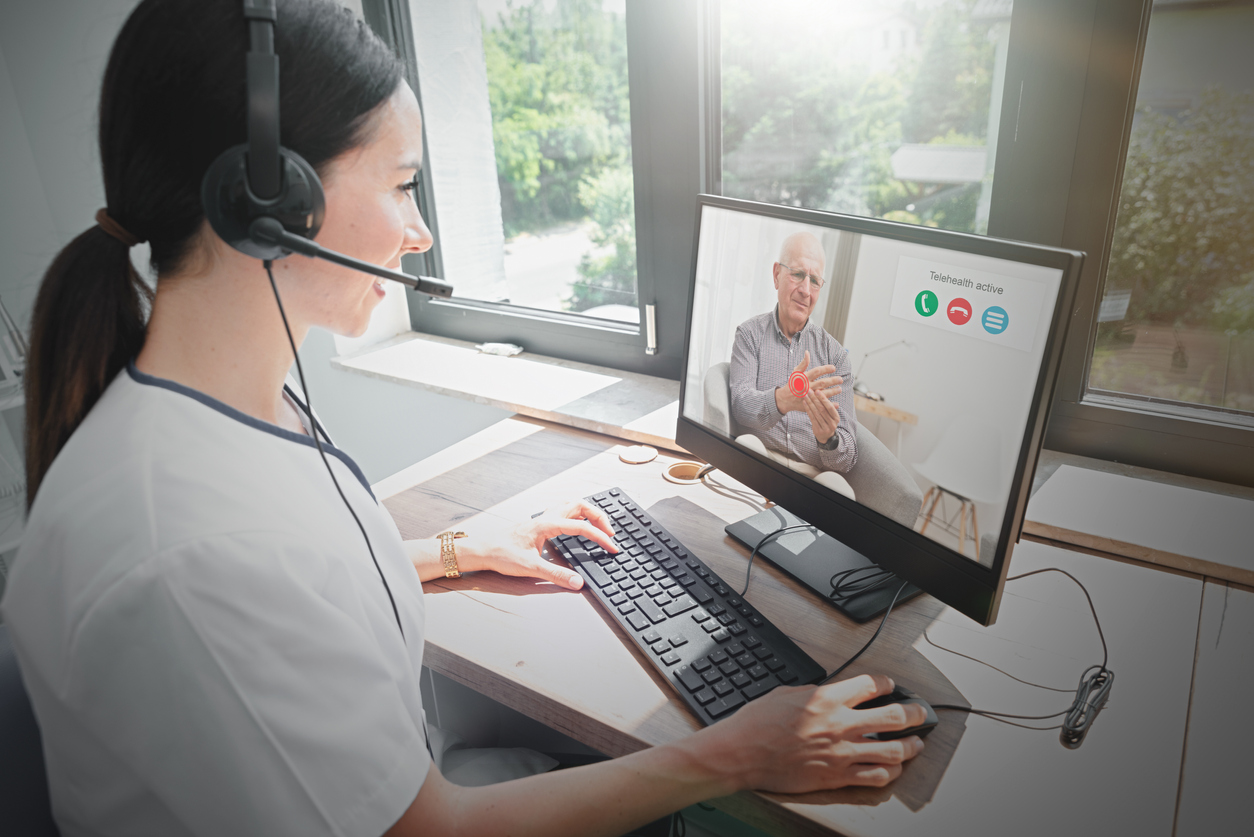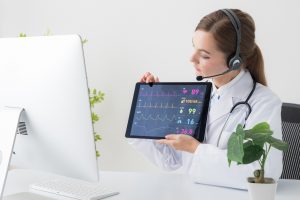
29 Mar Telemedicine and electronic private medical prescription approval
I have recently joined a panel of experts in telemedicine in Spain, hand in hand with an important Business School, where 12 professionals, among other aspects, are going to write and present to the appropriate ministries a report that serves the government for the use intensive information technology for telemedicine in society.
Telemedicine
Telemedicine is here to stay and grow as a measure that will solve different problems that we have in this society and that these days are even more evident. We are facing a revolution in the healthcare paradigm, not exempt from barriers that we must evolve, such as the regulatory ones that I will name later, cultural change, massive access to digital media and investment by the state in these technologies that, when properly applied, generate return (ROI) short term.
What services can we find in telemedicine?

Currently implemented telemedicine encompasses videoconferencing and some more value-added services that alone already provide enormous value in the doctor-patient relationship. It is evident that being able to be attended without travel, a second opinion, follow-up of chronic patients or those with a special contagion is immediate. However, telemedicine can be applied and expanded with services that provide added value that I would like to name and propose in this scenario:
Record your symptoms on an electronic device that the user may have at home, biometrics of different kinds with gadgets to use or provided by the health expert. This will allow you to gather important information about how your illness affects you while doing everyday tasks, whether at home or away from home. These measurements are transmitted to the medical professional in real time, which can be stored in Big Data systems for subsequent analysis, comparison, predictions or classifications, for example using Artificial Intelligence algorithms.
Support for patient education and self-management of their treatment. The information that a patient can receive through these tools, share with other patients their same conditions, experiences, etc. is a value called peer experience. Self-management is that any computer tool focused on telemedicine can help the patient manage their treatment, anticipate possible problems, identify progress, etc.
Prescription. Within my competences as the first auditor in Spain of private electronic medical prescription, this support for telemedicine, by means of the medical prescription that could be prescribed and integrated in the pharmacy, closes the patient care circuit, being able to download procedures, bureaucracy, etc. with secure systems that guarantee what we call in CDI audit (Confidentiality, Availability and Integrity) in this case related to the prescriptions that a patient could receive through the electronic private medical prescription, including integration with insurers.
Primary care in emergencies, in situations that need a quick response to refer to the face-to-face or traditional system if necessary.
Use of artificial intelligence to detect and classify patient states and their evolution through probabilities.
Tele meets panels of medical experts to discuss pandemics or simply to share information or second opinions at a professional level.
What benefits does telemedicine provide in the short term of implementation?
The advantages that the patient receives are of rapid adoption, I will only name some of them that are key to the perceived improvement in the implementation of telemedicine:
On the one hand, we have within our reach some of the services that we could only enjoy in outpatient clinics, etc., with greater control over our diseases or health incidents.
We eliminate tedious displacements, waiting rooms, etc., making it possible to improve the care of dependencies, handicaps, etc., being able to directly impact long-term treatments that require residence for long periods of time or in unpopulated or difficult-to-access geographical situations.
Healthcare costs are significantly reduced, being able to attend more patients with less costs, 24×7 optimizing a possible shortage of professionals in the medium term.
Without forgetting that the private doctor’s business is in full transformation, being able to offer its services to a greater public within its local reach.
What is the situation in Spain in Telemedicine?
According to some official data, we are one of the leading countries in telemedicine, although it seems otherwise. The data of the European Commission reveal that Spain is the country that makes the most tele-consultations and that requests the most appointments through the Internet. We are also among those who download the most health apps.
The average in Europe when requesting appointments on the Internet is around 15% while we already reached 40%, very positive data in the use of this type of telemedicine advantages. Thus, the use of Internet consultation according to the European Commission increases especially among young people between 16 and 24 years old, being the fifth country in “m-Health”, health apps.
Interest in telemedicine in Spain will improve public health spending, affected by the aging of the population and the codification of diseases, with enormous potential to prevent health spending from skyrocketing to unsustainable levels in a short time.
Studies guarantee that if we promote telemedicine it could impact around a 20% reduction in healthcare spending, for example only traveling would save millions of euros for public, but also private healthcare (4,000 million according to a CAP GEMINI study).
How does the electronic private medical prescription affect telemedicine?
As I have previously introduced the approval of apps and information systems in the electronic private medical prescription requirements, it would allow telemedicine systems to substantially expand their capabilities.
Let’s understand some key aspects in the approved systems in this matter:
Soon the prescriptions in the electronic private medical prescription systems will allow dispensing in the pharmacy the medicines that a private doctor in the private clinic has prescribed for us by reading a data matrix on, for example, our smartphone.
The privacy of those highly confidential treatments is ensured in these systems.
The management of narcotic drugs, with the control measures that this homologation requires, are simple to implement.
Control of dispensed packaging, dates, cancellations, drug substitutions, and other aspects related to dispensing help prevent fraud, reduce fraud, and help adjust costs for both the patient and clinics.
The management of tutored as children, dependents, etc. through this system is applied automatically, being able to manage your medications automatically without excessive bureaucracy.
As telemedicine systems move from diagnosis to prescription and dispensing as a continuous flow of information, the patient and society will see more quickly that the circle of telemedicine has really closed.
How does cybersecurity affect telemedicine?
One of the aspects when a software obtains the approval of an electronic private medical prescription, as well as it is applicable to all interactions through telemedicine systems, is that these are exposed to the Internet and therefore to potential risks of cyberattacks.
Cybersecurity measures are key to giving confidence to users, clinical entities, government and ultimately to all of society that these systems are robust and do not allow security breaches.
In this regard, and as CISA Auditor for ISACA, I would highlight the need to adopt the security measures for the approval of an electronic private medical prescription, citing below some key elements:
Penetration test or also called ethical hacking to prevent potential risks or vulnerabilities.
Adoption of information and security standards such as ISO27001 with its 114 control points.
IPS or intrusion prevention systems.
IDS or intrusion detection systems.
In general, guaranteeing that the telemedicine systems and therefore the information that we exchange in them is confidential and secure is essential for the patient and medical professional to trust this type of system.
What are the main brakes that exist in the adoption of telemedicine?
Understanding that at this point in the article, the reader may have understood the number of advantages that we can apply at this time and in the future with telemedicine in society, there are still many brakes that with our work in this panel of experts we must help reduce or remove. I will highlight 5 of them that seem key to me:
Patients and professionals still do not have the knowledge and confidence of the use that these types of solutions provide them. Therefore we are facing an opportunity to evangelize telemedicine.
Although the homologation of the electronic private medical prescription systems has come to try to give interoperability between doctors, clinics, patients and official pharmacies and schools, mainly through NODOFARMA, there is still a way to improve the connection of the different actors.
Lack of real studies or success cases that show that telemedicine is advantageous in many settings. I think that given the current situation, no one can doubt that we are in a moment where telemedicine can help in an incredible way, being able, for example, to be attended by practically any doctor in the world without leaving home.
A legal and legal framework divided even by provinces that does not help the simplicity of telemedicine care.
Public medicine must adopt this type of system as a reference for the rest of the entities to carry it out, setting an example and beginning to be the way forward.
What laws affect, curb or support telemedicine?
Without being a lawyer, but if from my experience as a medical prescription auditor and expert collaborator with the justice that keeps me close to the lawyers constantly, I would like to highlight some issues that act as a brake or that complicate the adoption of telemedicine and that precisely in this panel We must work with experts and propose measures for improvement and flexibility for citizens:
Understanding that we are facing a sector that due to inertia and history we can call “traditional” in the adoption of this treatment methodology, regulation is not an aspect that may not be contemplated to grow the advantages of telemedicine in our country. Moreover, it is one of the brakes that has been considered so far and that with our panel of experts we try to try to affect or improve so that the level of penetration of telemedicine can be increased.
In most EU Member States the professional organization is the one that establishes the rules of professional practice and ethical control. Telemedicine service providers are assumed to meet the professional practice requirements of the Member State in which they are established.
There are other aspects of compliance with those relating to the maximum levels of compliance with directives 95/46 / EC and 2002/58 / EC on data protection and privacy in electronic communications, LSSI CE and RGPD, as well as Article 8 of the EU Charter of Fundamental Rights
Regulation 883/2004, on the coordination of social security systems, which does not apply to telemedicine because it affects the physical presence of the patient in the Member State of treatment.
Others (source https://latelemedicina.es/index.php/2018/02/19/se-regula-la-telemedicina-espana/):
Law 16/2003 on Cohesion and Quality of the National Health System.
Organic Law 15/1999, of December 13, on the Protection of Personal Data and Royal Decree 1720/2007, which develops it.
Law 34/2002 of July 11, on services of the information society and electronic commerce.
Law 14/1986, General Health.
Law 41/2002, on Patient Autonomy.
Law 34/1988, General Advertising; Royal Legislative Decree 1/2007, of the General Law for the Defense of Consumers and Users.
Royal Decree 81/2014, of February 7, which establishes rules to guarantee cross-border healthcare.
More information at https://www.cgcom.es/europa_al_dia/2013/390
Conclusion
In our panel of experts we are going to work to develop a complete study whose objective is none other than improving society’s health care based on services supported by information technology and telemedicine. Once completed, we will try to reach government entities that can take it into account to improve the current and future situation of the medical profession and patient care.
The approval of electronic private medical prescription comes to support these systems to give confidence to stakeholders in the value chain, ensuring privacy, confidentiality, availability, etc. of services between patient-doctor-dispensing office.
Luis Vilanova Blanco. First Auditor in Spain of electronic private medical prescription.
606954593
recetamedica@luisvilanova.es




